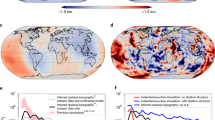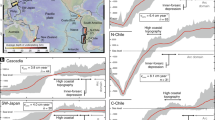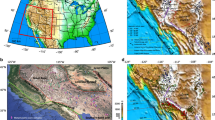Abstract
THE movement of continents with respect to a large-scale pattern of dynamic topography and geoid, imposed by convection in the mantle, must contribute to the flooding of continental platforms. Here I investigate this phenomenon, using a one-dimensional model in which a continent moves from a high to a low of dynamic topography (and geoid), and in the process is partially exposed and then flooded. If the dynamic topography is greater than about 150 metres, the model continent is flooded by more than 30%—the maximum amount of flooding experienced by North America during the entire Phanerozoic eon1. The model suggests that a large-scale pattern of dynamic topography must have an amplitude of less than 150 metres, and that the admittance, the ratio of geoid to dynamic topography, may be greater than 0.3. Recent models of global mantle dynamics2,3 which predict the long-wavelength geoid from mantle seismic structure are apparently inconsistent with Phanerozoic flooding.
This is a preview of subscription content, access via your institution
Access options
Subscribe to this journal
Receive 51 print issues and online access
$199.00 per year
only $3.90 per issue
Buy this article
- Purchase on Springer Link
- Instant access to full article PDF
Prices may be subject to local taxes which are calculated during checkout
Similar content being viewed by others
References
Wise, D. U. in The Geology of Continental Margins (eds Burk, C. A. & Drake, C. L.) 45–58 (Springer, New York, 1974).
Hager, B. H., Clayton, R. W., Richards, M. A., Comer, R. P. & Dziewonski, A. M. Nature 313, 541–545 (1985).
Hager, B. H. & Clayton, R. W. in Mantle Convection (ed. Peltier, R. W.) 657–763 (1989).
Hays, J. D. & Pitman, W. C. Nature 246, 18–22 (1973).
Kominz, M. A. Am. Ass. Petrol. Geol. Mem. 36, 109–127 (1984).
Dziewonski, A. M. J. geophys. Res. 89, 5929–5952 (1984).
Dziewonski, A. M. & Woodhouse, J. H. Science 236, 37–48 (1987).
Cazenave, A., Souriau, A. & Dominh, K. Nature 340, 54–57 (1989).
Cazenave, A., Dominh, K., Rabinowicz, M. & Ceuleneer, G. J. geophys. Res. 93, 8064–8077 (1988).
Harrison, C. G. A., Miskell, K. J., Brass, G. W., Saltzman, E. S. & Sloan, J. L. Tectonics 2, 357–377 (1983).
Algeo, T. J. & Wilkinson, B. H. J. geol. Soc. London. (in the press).
Harrison, C. G. A. et al. Earth planet. Sci. Lett. 54, 1–16 (1981).
Anderson, D. L. Nature 297, 391–393 (1982).
Gurnis, M. Nature 332, 695–699 (1988).
Gurnis, M. Geophys. Res. Lett. (in the press).
Author information
Authors and Affiliations
Rights and permissions
About this article
Cite this article
Gurnis, M. Bounds on global dynamic topography from Phanerozoic flooding of continental platforms. Nature 344, 754–756 (1990). https://doi.org/10.1038/344754a0
Received:
Accepted:
Issue Date:
DOI: https://doi.org/10.1038/344754a0
This article is cited by
-
Syn-rift unconformities punctuating the lower–middle Cambrian transition in the Atlas Rift, Morocco
International Journal of Earth Sciences (2015)
-
An alternate perspective on the opening and closing of the intracratonic Purana basins in peninsular India
Journal of the Geological Society of India (2015)
-
Phanerozoic marine inundation of continents driven by dynamic topography above subducting slabs
Nature (1993)
-
Large-scale mantle convection and the history of subduction
Nature (1992)
Comments
By submitting a comment you agree to abide by our Terms and Community Guidelines. If you find something abusive or that does not comply with our terms or guidelines please flag it as inappropriate.



